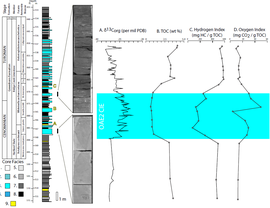Understanding ocean chemistry in the Western Interior Seaway during the Cenomanian–Turonian Extinction Event.
[sciencythoughts.blogspot.com]
The boundary between the Cenomanian and Turonian stages of the Cretaceous Period is marked by a mass extinction event that saw the demise of a quarter of the marine invertebrates present at the onset of the crisis, combined with carbon, oxygen, and sulphur isotope levels, the deposition of a thick (up to 3 m in places), organic-rich, black shale in many ocean basins, and the onset of a greenhouse climate, known as the Cretaceous Climatic Maximum, which peaked in the early Turonian, then gradually cooled off over the remaining 24 million years of the Cretaceous. Numerous causes have been proposed for the Cenomanian–Turonian Extinction, but the most likely is thought to be massive volcanic emplacements, possibly in the Caribbean Large Igneous Province, which injected large amounts of carbon dioxide, hydrogen sulphide, and sulphur dioxide, as well as a variety of metal compounds, into the ocean-atmosphere system. Increasing atmospheric carbon dioxide would have led to higher global temperatures and higher precipitation on land, which in turn would have led to higher erosion on land, more nutrients being washed into the oceans, and vast Algal Blooms, which would be recorded as a higher burial rate for organic carbon, causing the global carbon isotope excursion, which can be observed from both black shales and carbonate rocks spanning the Cenomanian–Turonian boundary. At the time much of the world's ocean system was dominated by shallow, epicontinental seas (i.e. seaways covering continents in the already warm Cretaceous world), which would have quickly become stagnant when these Algal Blooms were combined with a combination of an injection of oxygen consuming metals and a break-down in ocean circulation caused by the rising temperatures, resulting in large portions of the global ocean becoming anoxic and hostile to multicellular life. The widespread occurrence of black shales at the Cenomanian–Turonian boundary is thought to be a reflection of this. Curiously, however, these phenomena are not recorded in all sequences spanning the Cenomanian–Turonian boundary, with many shallow marine environments (which would be predicted to be the most severely impacted by such events) seemingly unaffected. This variability, with the event leaving a strong signal in some sequences, a light one in others, and being totally absent in some places, leads to the conclusion that the 'global event' may in fact have been a series of overlapping local occurrences, driven by multiple factors rather than a single change in global atmospheric composition.


Enjoy being online again!
Welcome to the community of good people who base their values on evidence and appreciate civil discourse - the social network you will enjoy.Create your free account
Recent Visitors 12
JoeB
UK
Notlost
Northeastern Oklahoma,
jasen
Glen Ellyn,
racocn8
Culver City,
JackPedigo
Lopez Island,
Photos 292 More
Posted by JoeBKite-like structures in the western Sahara Desert.
Posted by TriphidAn Aussie Indigenous Message Stick.
Posted by TriphidIndigenous Australian Aboriginal Rock art dated somewhere between 20 and 30 thousand years old.
Posted by TriphidIndigenous Australian Aboriginal Rock art dated somewhere between 20 and 30 thousand years old.
Posted by TriphidIndigenous Australian Aboriginal Rock art dated somewhere between 20 and 30 thousand years old.
Posted by TriphidIndigenous Australian Aboriginal Rock art dated somewhere between 20 and 30 thousand years old.
Posted by JoeBDortoka vremiri: A new species of Dortokid Turtle from the Late Cretaceous of the Hațeg Basin, Romania.
Posted by JoeBThe Cabeço da Amoreira burial: An Early Modern Era West African buried in a Mesolithic shell midden in Portugal.
Posted by JoeBMusivavis amabilis: A new species of Enantiornithine Bird from the Early Cretaceous Jehol Biota of northeastern China.
Posted by JoeBTorosaurus in Canada.
Posted by JoeBStone tools from the Borselan Rock Shelter, in the Binalud Mountains of northeastern Iran.
Posted by JoeBDating the Lantian Biota.
Posted by JoeBBashanosaurus primitivus: A new species of Stegosaur from the Middle Jurassic of Chongqing Municipality, China.
Posted by JoeBDetermining the time of year when the Chicxulub Impactor fell.
Posted by JoeBSão Tomé and Príncipe: Possibly the last country on Earth never to have been visited by a working archaeologist.
Posted by JoeBMambawakale ruhuhu: A new species of Pseudosuchian Archosaur from the Middle Triassic Manda Beds of Tanzania.
Members 658Top
Moderator
Related GroupsMore
Religion of Science & Higher Consciousness
77 members
Political Posts, Articles and Memes
169 members
"I was blocked!?" Group
95 members
Conservative Bashers And Progressive Pushers
136 members
Community Senate
381 members
Trump Pinata
1142 members
Out Of The Illusion
1742 members
FreeThinkers
2693 members






